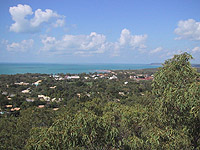Tanya's | Travels
|
Tanya's | Travels |
|
|
Europe | Asia | Africa
Australia (Arnhem Land)Copyright © Tanya Piejus, 2002 Cape Arnhem is where flip-flops go to die. So do chess pieces, umbrella handles, fluorescent tubes, empty bottles of talcum powder, hypodermic needles and Teenage Mutant Ninja Turtles. I discovered this odd fact while doing a marine debris survey with Conservation Volunteers Australia. For a month I tried to do my bit for global conservation by tidying up a small corner of Arnhem Land in the far north of the Northern Territory. It took us eight hours of bouncing in a four-wheel drive Land Cruiser along a rough, red dirt road to reach Nhulunbuy, our base. The town, also known as Gove, was built by a mining company to house and serve its employees. It's a strange sort of place with a strange mix of people. The plush suburbs house miners and their families who are there to stay, growing fat on big salaries and very little to spend them on. The hostel we stayed in houses a workforce of 400, mainly single, men who do twelve-hour shifts at the mine, spend their pay in the local pubs and come from the far corners of the globe. A transient population of fisherman and boaties hang out at the Yacht Club and the local Aboriginals come into town for cheap booze which is outlawed in their communities. Amongst them all, there was my group of nine volunteers from all over Australia, plus a CVA leader, with myself as the token Pom. Our first ten days were spent camping out in the bush and working with a landcare group in one of the nearby Aboriginal communities. I say 'working' but it ended up being more of a cultural exchange. We killed a few pestilent coffee bush trees one day and cleared a space for a campsite. But the rest of the time we walked the stunning beaches of Cape Arnhem collecting oysters and winkles, watched damper loaves rise in the hot coals of a campfire, boiled up billy tea, fished with a handline for long tom, played with the community kids, searched for turtle eggs and learnt the secrets of Aboriginal bushtucker. The hard yakka, as the Aussies like to say, began after we moved into the miners hostel and swapped tents, swags and campfire cooking for air-conditioning, duvets and total pig-outs in the miners' canteen. We needed the body fuel for digging silt traps to stop the Cape eroding away during the wet season. Heavy strips of rubber reinforced with steel had been laid on the Cape Arnhem four-wheel drive track to help vehicles over the sand. We had to remove them as they'd become mangled by irresponsible drivers and were causing more harm than good. Lugging ute-fuls of rock, we filled the sandy corners of the track to stop vehicles becoming bogged and tearing up the road even more. It was 30 degrees in the shade and we sweated out water as fast as we drank it in. Finally, we got to work on the marine debris survey for WWF Australia. The water in the huge Gulf of Carpentaria moves slowly clockwise and all the rubbish that's been dumped into it washes up on the otherwise unspoilt tip of beautiful Cape Arnhem. Our task was to collect this debris, catalogue it and dispose of it somewhere that wouldn't ruin the natural splendour of what became my favourite part of Australia. Cape Arnhem is remote, rugged and wild with its unending sweeps of wind-whipped white sand, its dense forests of pandanus trees and palms, outcrops of hard, grey rock and pounding turquoise ocean. It was an extraordinary month off the usual backpacker circuit. One day we found an exhausted turtle in danger of ending up as dinner for a sea eagle. We rescued it, named it Soup and sent it to Darwin to be treated. I bought a traditionally-made didgeridoo and heard it played on the site where the instrument was very first used to call the clans together. We drove to the tip of the Cape where mere tourists aren't given permission to go and stood on sacred land listening to the gurgling of the sea. And we collected over 1700 abandoned flip-flops, in all colours and sizes but, strangely, mostly right-footed. |

Nhulunbuy or Gove Amazon.co.uk picks:
|